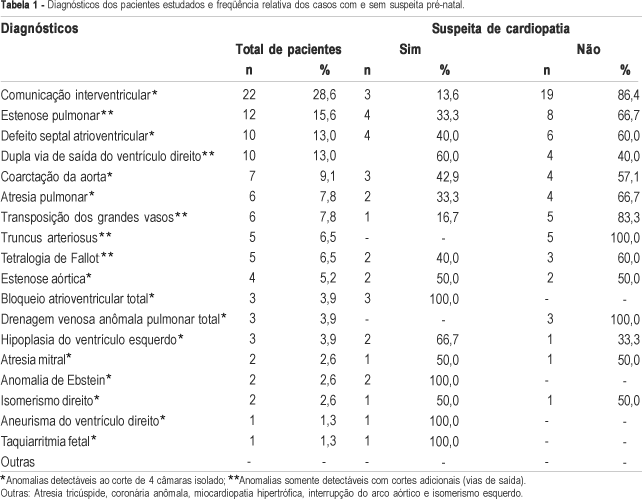Purpose: to evaluate the role of routine obstetrical ultrasound scan in suspecting the presence of fetal congenital heart diseases and severe arrhythmias, as well as the factors involved in its accuracy. Methods: the sample was made up of 77 neonates and infants hospitalized at the Institute of Cardiology of Rio Grande do Sul from May to October of 2000, with confirmed postnatal diagnosis of structural heart disease or severe arrhythmia, whose mothers had been submitted to at least one obstetrical ultrasound scan after 18 weeks of gestation. After informed consent, a customized standard questionnaire was used. Categorical variables were compared using chi² test or Fisher's exact test and a logistic regression model was used to determine independent variables possibly involved in the prenatal suspicion of cardiac abnormalities. Results: in 19 patients (24.6%), obstetrical ultrasound was able to rise prenatal suspicion of structural or rhythm abnormalities. Considering only congenital heart diseases, this prevalence was 19.2% (14/73). In 73.7% of these cases, the cardiac disorder was accessible by the four-chamber view alone. Arrhythmias during obstetrical scan were observed in 26.3 of the babies with prenatal suspicion of a heart abnormality, while only 3.4% of the patients without prenatal suspicion showed a rhythm alteration (p=0.009). Significant differences between the groups with and without prenatal suspicion of cardiac abnormalities were observed in relation to parity (p=0.029), delivery by cesarean section (p=0.006), need for intensive care (p=0.046) and school education level of the father (p=0.014). At multivariate analysis, only the presence of a rhythm alteration during ultrasound scan was shown to be an independent variable associated with prenatal suspicion of cardiac abnormalities. Conclusions: routine obstetrical ultrasound has been underused in prenatal screening of congenital heart diseases. Adequate training and making obstetricians and the population a ware of the problem may be instruments for increasing the efficacy of routine obstetrical ultrasound in rising the suspicion of fetal cardiac abnormalities.
Ultrasonography; Fetal heart; Congenital defects; Intrauterine diagnosis

